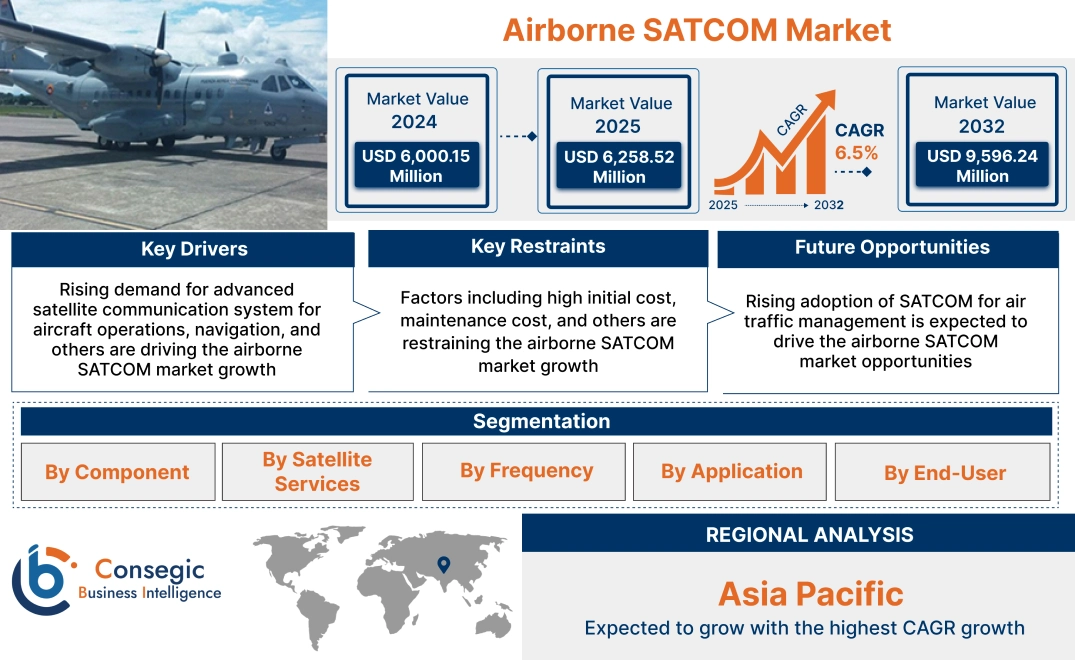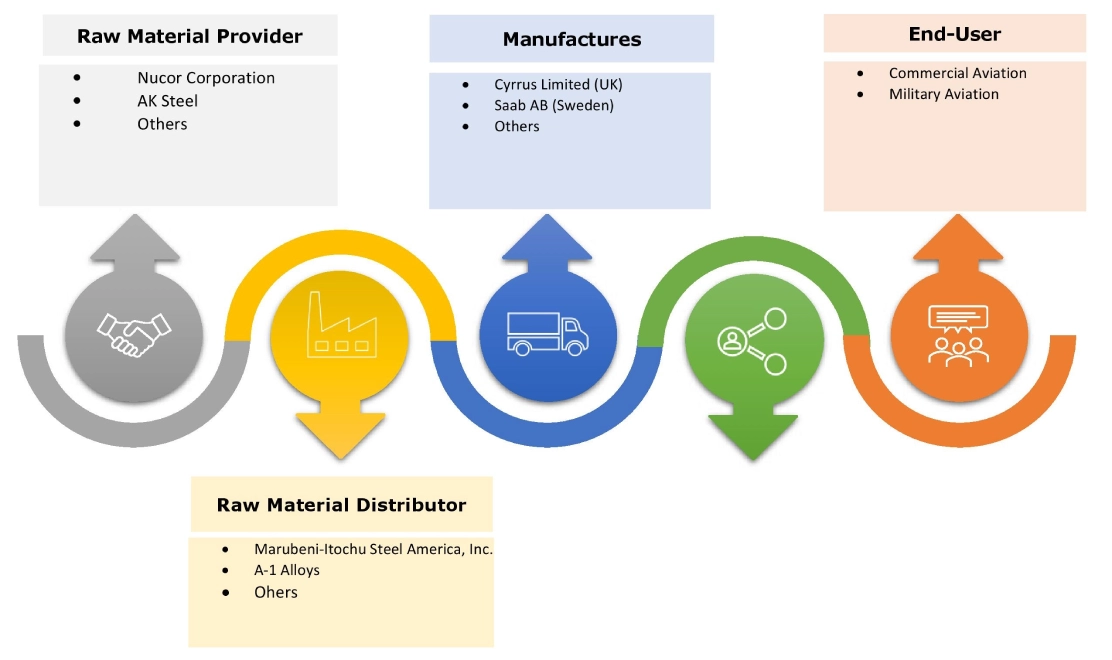- Summary
- Table Of Content
- Methodology
Airborne SATCOM Market Size:
Airborne SATCOM Market size is estimated to reach over USD 9,596.24 Million by 2032 from a value of USD 6,000.15 Million in 2024 and is projected to grow by USD 6,258.52 Million in 2025, growing at a CAGR of 6.5% from 2025 to 2032.
Airborne SATCOM Market Scope & Overview:
Airborne SATCOM refers to a satellite communication which transmits signal from transponder by creating a channel between the transmitter and receiver. Further, airborne satellite communication provides data transmission, real time communication, and connectivity between aircraft and ground stations. Additionally, airborne satellite communication is used in various application including navigation, surveillance, communication, weather forecasting, and others. Moreover, airborne satellite communication offers various benefits including enhanced situational awareness for pilots, which ensures reliable communication during long haul and transoceanic flights, supports internet access to flights while travelling, and others.
Key Drivers:
Rising demand for advanced satellite communication system for aircraft operations, navigation, and others are driving the airborne SATCOM market growth
The primary factor driving the adoption of airborne satellite communication includes its various application in navigation, surveillance, communication, weather forecasting, and others. Further, airborne satellite communication systems enhances navigation of aircraft by providing tools for directing, monitoring, and managing aircraft movement. Additionally, airborne satellite communication offers real time updates for military flight operations, supports in flight connectivity between base stations and pilots, and improves safety and security of aircraft. This above factors are further driving the adoption of satellite communication in aircraft.
- For instance, in May 2023, Honeywell International Inc. launched new small SATCOM system for advanced air mobility market. This system called as VersaWave, combines SATCOM, cellular (i.e., 5G, 4G, 3G), Wi-Fi, and Bluetooth connectivity in an extremely small, lightweight package.
Thus, the increasing advancements in satellite communication solutions for various application including aircraft operations, navigation, and others are driving the airborne SATCOM market size.
Key Restraints:
Factors including high initial cost, maintenance cost, and others are restraining the airborne SATCOM market growth
The deployment of airborne SATCOM systems is primarily restricted due to various factors including high initial investment and regular maintenance costs. Advanced SATCOM hardware such as antennas, receivers, and satellite transceivers requires significant capital expenditure.
Additionally, there is an increase in operational costs due to frequent calibration, software updates, and the need for skilled technicians for operating advanced satellite technologies. Further, the integration of modern SATCOM technology with the existing satellite infrastructure is usually complex, which in turn may hamper its widespread adoption. The above factors are further constraining the airborne SATCOM market expansion.
Future Opportunities :
Rising adoption of SATCOM for air traffic management is expected to drive the airborne SATCOM market opportunities
There is an increase in air traffic globally, due to growing demand of air travel in tourism sector. Further, the growing air travel is attributed to various factors including growing disposable income, expansion of low cost carriers, rise in business travel, and increasing trade through air cargo services. Additionally, the rise in air traffic drives the adoption of enhanced satellite communication systems for ensuring reliable real time communication, efficient airspace management, minimizing delays, and others. Moreover, the rising advancements in airborne satellite communication for modern navigation, communication, and surveillance technologies enables swift operations.
- For instance, according to the International Air Transport Association (IATA), the total air traffic witnessed an increase of 36.9% in 2023 in comparison to 2022. This is further expected to increase the utilization of satellite communication technologies for air traffic management.
Thus, as per the airborne SATCOM market analysis, increasing air traffic due to rise in utilization of air services are driving the global airborne SATCOM market opportunities.
Airborne SATCOM Market Segmental Analysis :
By Component:
Based on the component, the market is segmented into antennas, transponders, frequency converters, filters, low-noise amplifiers (LNAs), switches, and others.
Trends in the Component:
- There is an increasing trend towards utilization of different antennas to transmit and receive electromagnetic signals for real time information sharing.
- Increasing utilization of communication networks for efficient management of aerial and ground control.
Antennas accounted for the largest revenue share of 29.32% in the total airborne SATCOM market in 2024.
- Antennas in satellite communication refers to specialized devices that transmit and receive electromagnetic signals between ground stations and satellites.
- Further, antennas in satellite communication enables wide range of services including navigation, surveillance, communication, and others.
- Additionally, antennas are widely used in telecommunication networks, military operations, weather forecasting, GPS (Global Positioning System), and more.
- For instance, Collins Aerospace offers high gain antenna in its product offerings. It offer features including compact design, variable frequency and power supply.
- Thus, the rising utilization of antennas for military operations, weather forecasting, GPS, and others are driving the airborne SATCOM market trends.
Transponders are anticipated to register a significant CAGR growth during the forecast period.
- A transponder is an electronic device in a satellite that receives signals from the ground, amplifies them, and re-transmits it to receivers with different frequencies.
- Further, transponders enable long distance communication by maintaining signal strength and minimizing interference, while ensuring seamless transmission for data, voice, and video.
- Additionally, transponders are widely used in airborne satellite communication for establishing channel between the transmitting and receiving antennas.
- For instance, Collins Aerospace offers HST–2110B high speed SATCOM transceiver in its product offerings. It offer features including small, lightweight design, and flexibility.
- Thus, the rising advancements related to transponder systems are driving the airborne SATCOM market trends.
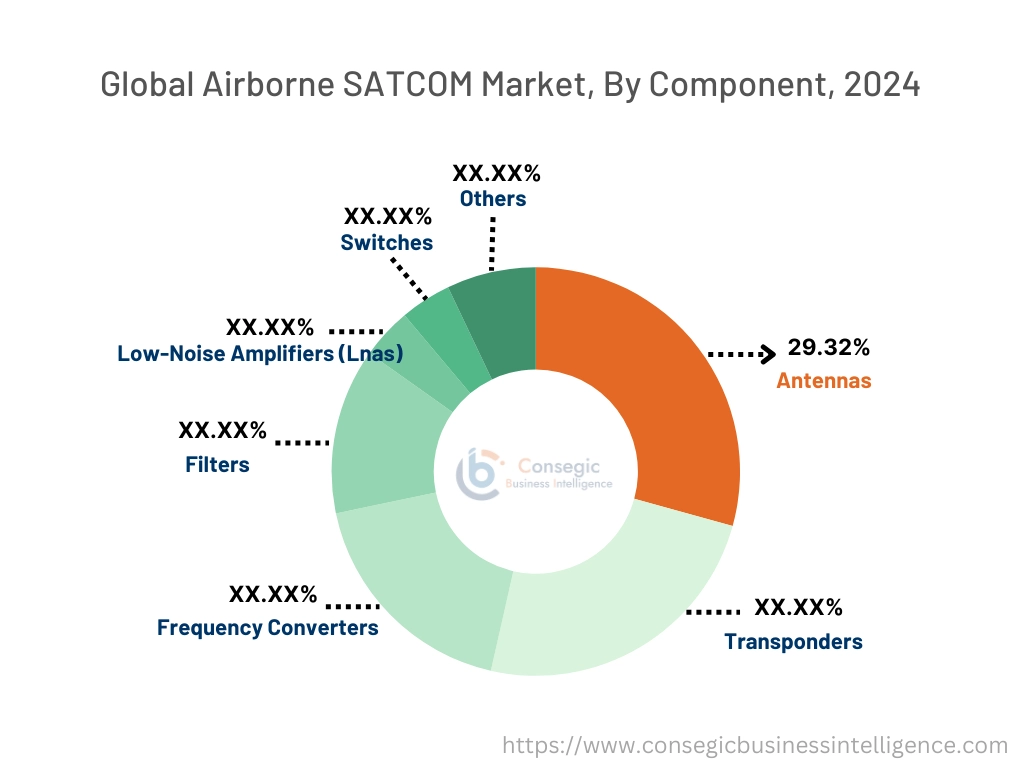
By Satellite Services:
Based on the satellite services, the market is segmented into mobile satellite services, navigational satellite services, meteorological satellite services, and others
Trends in the Satellite Services:
- There is an increasing trend towards utilization of SATCOM system for providing navigational satellite services including GPS to commercial and military aviation.
- Rising adoption of SATCOM for providing for providing meteorological satellite services in terms of rescue and search operations.
Mobile satellite services segment accounted for the largest revenue share in the total market in 2024 and it is anticipated to register a substantial CAGR during the forecast period.
- Mobile satellite services involves the use of telecommunication system that provides data, voice, and internet services to aircraft through satellites.
- Further, mobile satellite services offers reliable connectivity in regions where terrestrial mobile networks are not present.
- Moreover, mobile satellite services are used in aviation, disaster management, military operations, or travellers requiring interrupted communication.
- For instance, in January 2025, Thuraya Space42 launched Thuraya 4 Satellite into orbit for providing mobile satellite services for application in defense, government, and other related sectors.
- Thus, the rising advancements in mobile satellite services for providing reliable connectivity in different regions are driving the airborne SATCOM market size.
By Frequency:
Based on the frequency, the market is segmented into VHF/UHF band, L band, and others.
Trends in the Frequency:
- Rising utilization of L-band in commercial airports for enabling mobile communication services.
- Increasing adoption of VHF/UHF band in satellite communication systems for military operations with enhanced communication.
L band segment accounted for the largest revenue in the total market share in 2024.
- L Band refers to a frequency range of 1 – 2 GHZ within the radio spectrum, commonly used in satellite communication for applications requiring the less interference and high reliability.
- Further, L band is used in various applications including radars, mobile & satellite communication, and satellite navigation.
- For instance, Intellian offers SATCOM products with L-band capabilities in its product offerings. It offers various benefits including enhanced voice calling, improved reliability, and internet connectivity.
- Thus, as per the analysis, the rising utilization of L-band for satellite communication applications are driving the market.
VHF/UHF band is anticipated to register a substantial CAGR growth during the forecast period.
- Very high frequency ranges from 30-300 MHZ and ultra-high frequency ranges from 300 MHZ-3GHZ, which are used in satellite communication for transmitting signals over long distances.
- Further, VHF offers long range communication and UHF provides high bandwidth compared VHF, which reduces signal degradation.
- Additionally, VHF/UHF band is used in airborne SATCOM for navigation, two way radio communication, data transmission, and others.
- For instance, in June 2021, Airbus, a military satellite communications service provider, launched UHF communications services for the armed forces.
- Thus, as per the analysis, the rising advancements in VHF/UHF band satellite communication for military aviation are driving the market.
By Application:
Based on the application, the market is segmented into navigation, surveillance, communication, weather forecasting, and others.
Trends in the Application:
- Rising utilization of airborne SATCOM system in commercial airports for enabling secure and two way communication.
- Increasing adoption of satellite communication in commercial aviation applications for conducting air traffic management.
Communication segment accounted for the largest revenue in the total airborne SATCOM market share in 2024.
- Airborne satellite communication enables data connectivity, voice communication, and others between aircraft, ground stations, and other aircraft.
- Further, airborne satellite communication offers real time updates for flight operations, supports in flight connectivity for passengers, and improves safety and security of aircrafts.
- For instance, in July 2024, Thales signed a contract with French defence procurement agency (DGA) for providing 30 dual-band X/Ka satellite communication stations to the French Army.
- Hence, the rising investments in military aviation sector are driving the market.
Navigation segment is anticipated to register a substantial CAGR growth during the forecast period.
- Airborne satellite communication systems enhances navigation by providing tools for directing, monitoring, and managing aircraft movement in airspace and on runways.
- Further, it offers efficient aircraft operations and ensures safety, improves route optimization, reduces risks of collisions, and enhances communication between pilots and controllers.
- Moreover, aircraft rely on global positioning system (GPS) as an addition to traditional navigation systems due to its enhanced precision.
- For instance, OneWeb Technologies launched Astra service which offers navigation, positioning, and timing (PNT) service for aviation sector.
- Thus, as per the analysis, the rising utilization of satellite communication systems for navigation application is driving the market.
By End-User:
Based on the end-user, the market is segmented into commercial aviation and military aviation.
Trends in the End-User:
- Rising utilization of aircraft satellite system in commercial aviation for enabling real-time communication and in-flight entertainment.
- Increasing adoption of airborne satellite communication in military operations for conducting swift military operations in air.
Commercial aviation segment accounted for a significant revenue in the total airborne SATCOM market share in 2024, and it is anticipated to register a substantial CAGR growth during the forecast period.
- Airborne satellite communication system is primarily used in commercial aviation to ensure safe and efficient management of aircraft operations.
- Further, airborne satellite communication enables improved connectivity for passengers and pilots, providing in-flight entertainment, and real time communication.
- Moreover, these systems enhances passenger experience and supports advanced safety features such as weather monitoring and air traffic co-ordination.
- For instance, in January 2023, Boeing received an order of 561 commercial aircrafts including new customers such as Delta Air Lines, ANA, and others.
- Thus, as per the analysis, the rising development of commercial aviation is driving the market.
Regional Analysis:
The regions covered are North America, Europe, Asia Pacific, the Middle East and Africa, and Latin America.
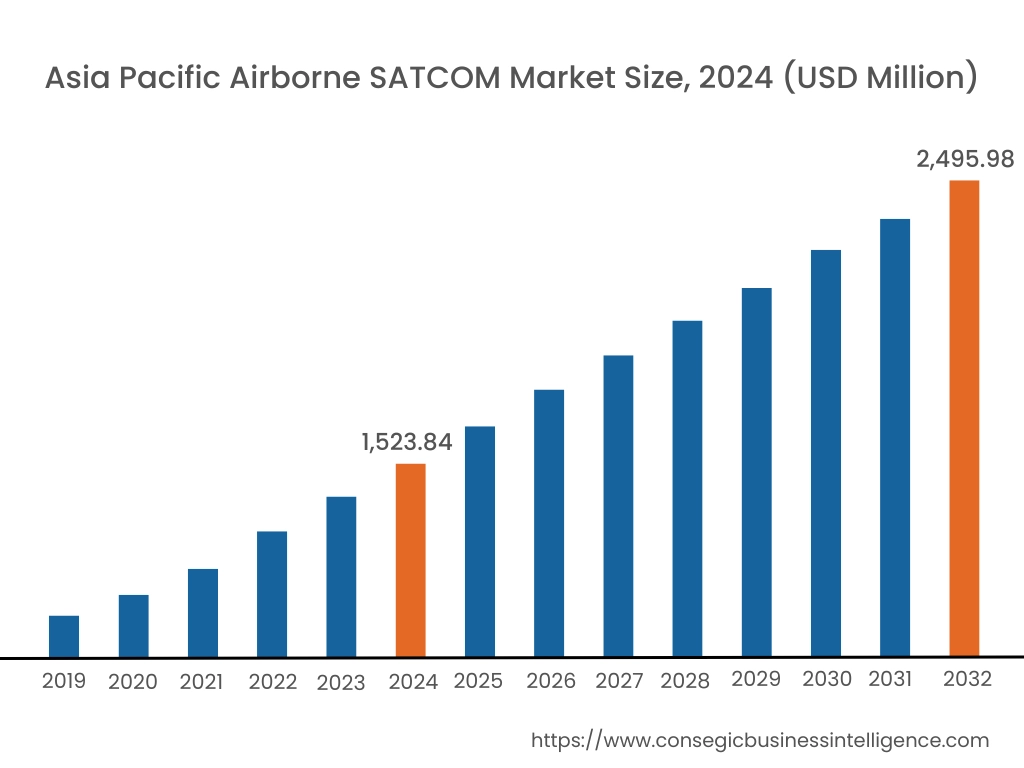
Asia Pacific region was valued at USD 1,523.84 Million in 2024. Moreover, it is projected to grow by USD 1,592.65 Million in 2025 and reach over USD 2,495.98 Million by 2032. Out of this, China accounted for the maximum revenue share of 35.2%. As per the airborne SATCOM market analysis, there is an increasing adoption of satellite communication in aviation sector, particularly in countries such as China, India, and Japan, due to rising investment in commercial airports for swift and smooth air transportation. The rapid development and growing investments in aviation industry are accelerating the airborne SATCOM market expansion.
- For instance, in October 2024, the Government of India allocated USD 72 billion in its budget for defense sector. Additionally, according to Government of India, the total number of operational airports in India increased from 74 airports in 2014 to 157 airports in 2024. The above factors are further projected to drive the market in the Asia-Pacific region.
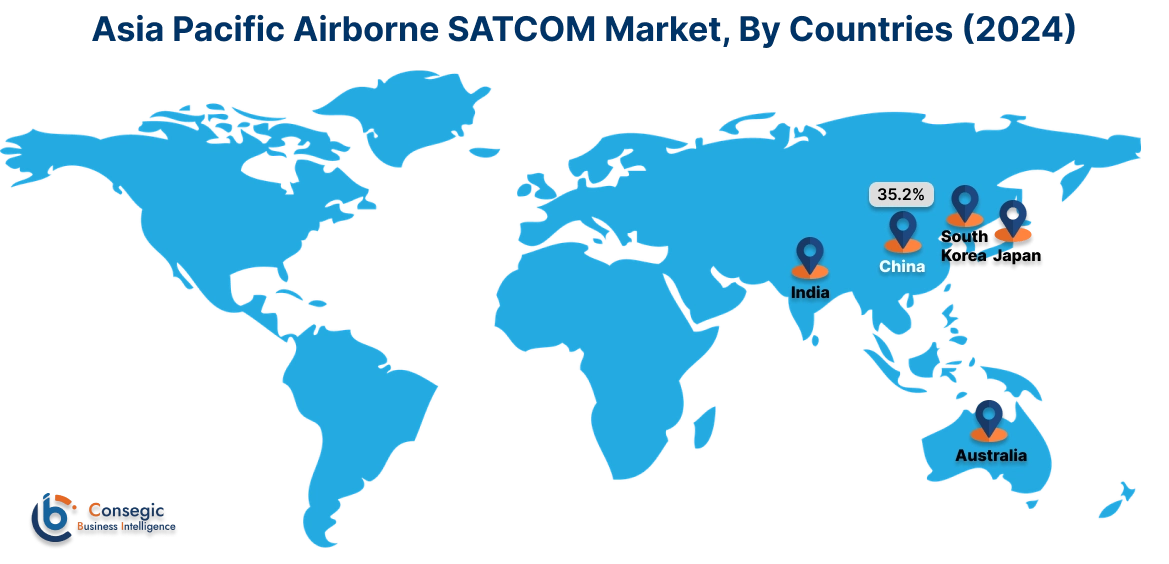
North America is estimated to reach over USD 3,541.97 Million by 2032 from a value of USD 2,233.31 Million in 2024 and is projected to grow by USD 2,327.86 Million in 2025. In North America, the growth of airborne SATCOM industry is driven by the rising investment in defense sector. Rising adoption of helicopters, fighter jets, aircraft for military operations are also driving the market. Further, the increasing investment in developing advanced military communication system is driving the adoption of airborne satellite communication, which is contributing to the airborne SATCOM market demand.
- For instance, according to the Department of Defense, the U.S. Government allocated USD 132.8 Billion for air force department in its defense sector. This is further expected to drive the adoption of airborne satellite communication systems, which in turn is expected to drive the market in North America during the forecast period.
The regional analysis depicts that the rising air traffic and growing commercial aviation are further driving the adoption of advanced airborne satellite communication solutions, in turn driving the airborne SATCOM market demand in Europe. Further, as per the market analysis, the primary factors driving the market growth in the Middle East and African region includes increasing investment in development of air infrastructure and aviation industry. The rising international trade through air is further driving the market demand in the Latin America region.
Top Key Players and Market Share Insights:
The airborne SATCOM market is highly competitive with major players providing products to the national and international markets. Key players are adopting several strategies in research and development (R&D), product innovation, and end-user launches to hold a strong position in the global airborne SATCOM market. Key players in the airborne SATCOM industry include -
- Honeywell International Inc. (US)
- Thales Group (France)
- Northrop Grumman Corporation (US)
- Cobham Aerospace Communications (UK)
- Ball Corporation (US)
- Collins Aerospace (US)
- General Dynamics Corporation (US)
- Raytheon Intelligence and Space (US)
- BAE Systems (US)
- L3Harris Technologies Inc. (US)
Recent Industry Developments :
Product Launch:
- In May 2023, Honeywell International Inc. launched VersaWave, a small SATCOM system for with cellular (i.e., 5G, 4G, 3G), Wi-Fi, and Bluetooth connectivity in an extremely small, lightweight package.
Partnerships & Collaborations:
- In November 2024, Thales Alenia Space collaborated with Leonardo for designing Koreasat 6A SATCOM, which is launched by SpaceX to enhance positioning performance of Global Navigation Satellite Systems (GNSS).
Airborne SATCOM Market Report Insights :
| Report Attributes | Report Details |
| Study Timeline | 2019-2032 |
| Market Size in 2032 | USD 9,596.24 Million |
| CAGR (2025-2032) | 6.5% |
| By Component |
|
| By Satellite Services |
|
| By Frequency |
|
| By Application |
|
| By End-User |
|
| By Region |
|
| Key Players |
|
| North America | U.S. Canada Mexico |
| Europe | U.K. Germany France Spain Italy Russia Benelux Rest of Europe |
| APAC | China South Korea Japan India Australia ASEAN Rest of Asia-Pacific |
| Middle East and Africa | GCC Turkey South Africa Rest of MEA |
| LATAM | Brazil Argentina Chile Rest of LATAM |
| Report Coverage |
|
Key Questions Answered in the Report
How big is the airborne SATCOM market? +
The airborne SATCOM market was valued at USD 6,000.15 Million in 2024 and is projected to grow to USD 9,596.24 Million by 2032.
Which is the fastest-growing region in the airborne SATCOM market? +
Asia-Pacific is the region experiencing the most rapid growth in the airborne SATCOM market.
What specific segmentation details are covered in the air traffic control equipment report? +
The air traffic control equipment report includes specific segmentation details for component, satellite services, frequency, application, end-user, and region.
Who are the major players in the airborne SATCOM market? +
The key participants in the airborne SATCOM market are Honeywell International Inc. (US), Thales Group (France), Collins Aerospace (US), General Dynamics Corporation (US), Raytheon Intelligence and Space (US), BAE Systems (US), L3Harris Technologies Inc. (US), Northrop Grumman Corporation (US), Cobham Aerospace Communications (UK), and Ball Corporation (US).
